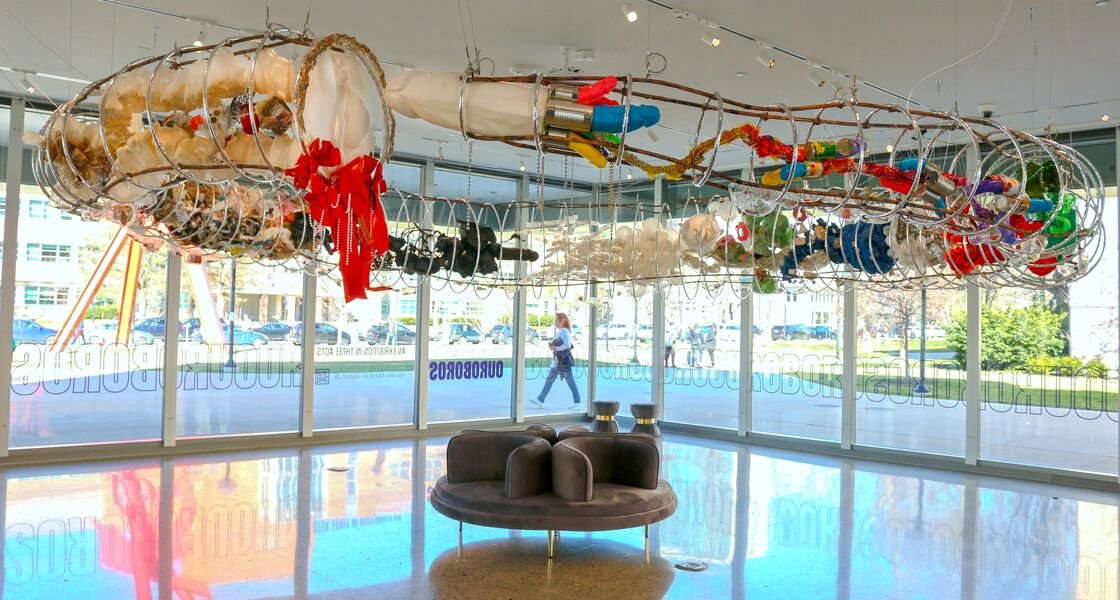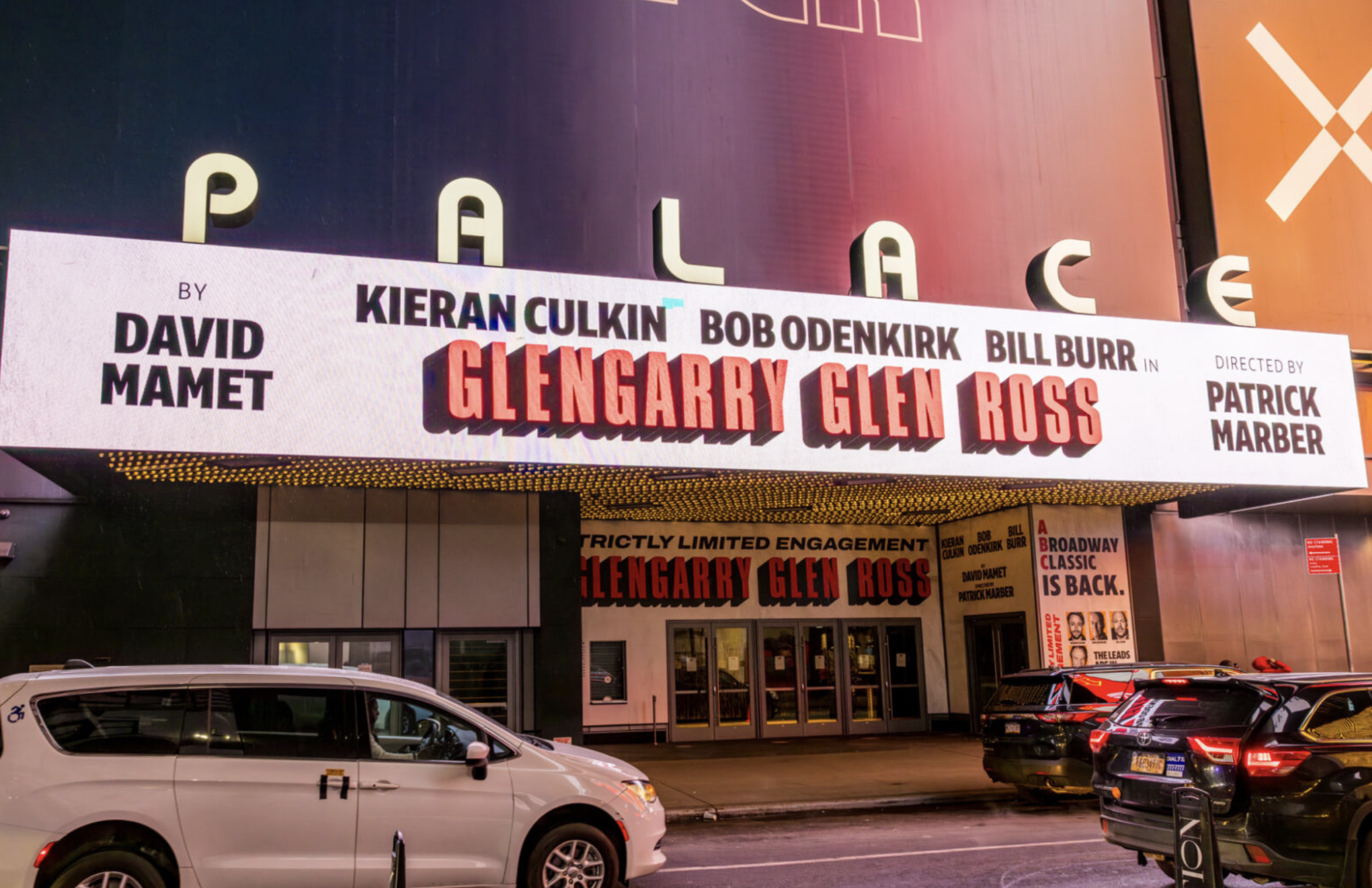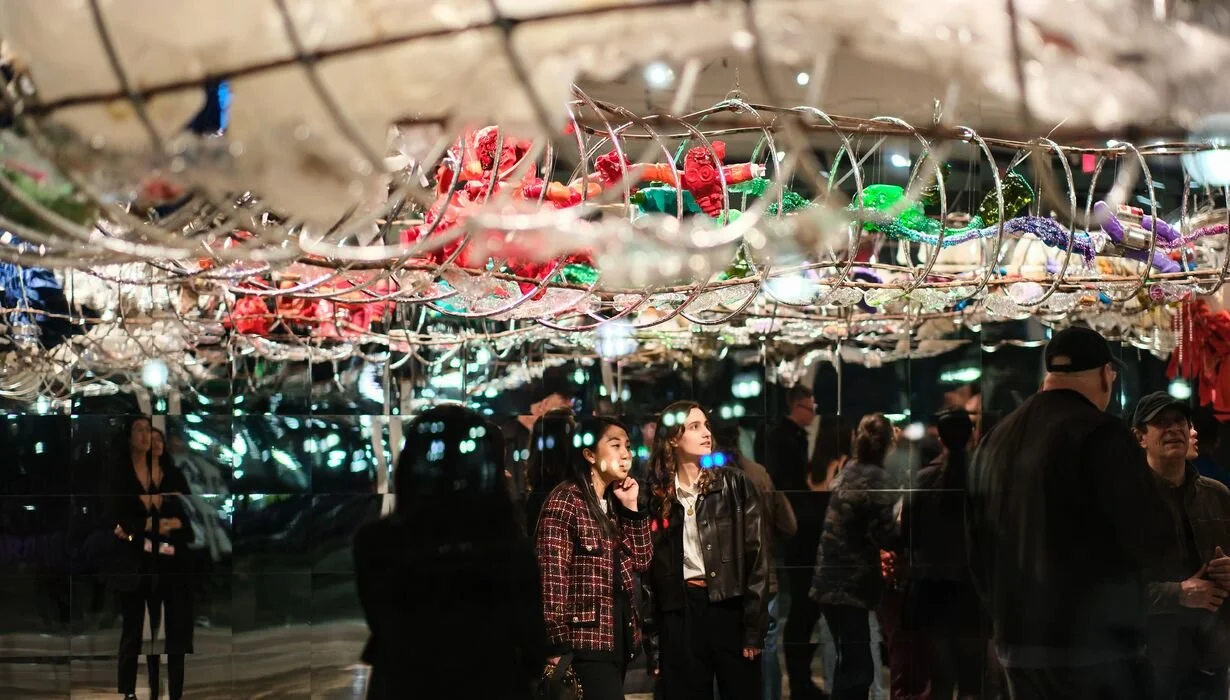Art Review: Ouroboros by Machine Dazzle at The University of Michigan Museum of Art
Curiously suspended yet completely present, a new installation at the University of Michigan Museum of Art is Machine Dazzle at his most progressive, aware, and fun.
Art Review: Ouroboros by Machine Dazzle (2024)
Opening night reception for the exhibition Ouroboros by Machine Dazzle on Thursday, March 14th, 2024 at UMMA. Image: Mark Gjukich.
Earlier this year, The University of Michigan Museum of Art commissioned New York-based artist, designer, and multifaceted maker Machine Dazzle for a site-specific installation at its Irving Stenn Jr. Family Gallery. To support production of the work, UMMA partnered with the University of Michigan’s Stamps School of Art & Design, awarding the annual Roman J. Witt Residency to Dazzle for the 2024 season.
The resulting installation debuted on March 14, 2024 and remains on view until August 25th, 2024. Titled Ouroboros, the work will undergo several maximal iterations, with unveilings taking in April and June. In June, the sculpture will become animated and wearable by a team of fifteen University of Michigan students.
Note
This review considers the work as presented at the time of opening on March 14, 2024.
Contextualizing Ouroboros
Irving Stenn, Jr. Family Gallery at The University of Michigan Museum of Art. Image: Google Maps
Before we talk about Ouroboros as an art piece, we must consider its context and location. Centrally positioned at the University of Michigan Museum of Art, the Irving Stenn Jr. Family Gallery is a challenging space to work with. Almost perfectly square and flooded with natural light on two sides, the gallery is situated on a busy and important crossing within the campus, making it both a highly-visible meeting and passing point.
A towering windowless mass on two axises squeeze and push the gallery’s windows down to eye level. The floor-to-ceiling windows draws outside viewers in but create a challenge for the occupying artist: how can one make the space interesting enough to be appreciated by a glancing public, yet worthy of deeper examination from intentional visitors? Natural light is often regarded as the enemy of art preservation, making this gallery all the more challenging to work with. Further, the gallery’s modern architectural flavor strongly counters the overall tone of the University’s Gothic and Neoclassical architectural constitution.
Machine Dazzle, Ouroboros (2024). Image: Christopher Ankney.
Fortunately, Machine Dazzle, the New York City-based artist known for the maximalist approach he’s refined over his multi-decade career, did not feel daunted by the challenge, nor did he leave any aspect of gallery space untouched. The result is an engrossing “more is more” installation that transcends the art piece alone and benefits of the work, incidental passerby, and intentional visitors in equal measure.
Encountering Ouroboros
Despite already having plenty of light in the gallery, Dazzle begins Ouroboros by covering the two walls not laden with windows with wall-height mirrors. Placed intentionally (and even architecturally) on the west/south axis, Dazzle effectively doubles the brightness of the room and work. However, in line with Machine Dazzle’s practice of using mostly found and recycled objects, these mirrors feature the small waves and imperfections that come with time and use— achieving a visual effect more suited to a funhouse than a fashion boutique. This approach also transforms Ouroboros itself from being a static structure into an undulating and manipulated item in constant motion, primarily driven by the viewer’s position.
With this arrangement, it is impossible to avoid the primary manifestation of Ouroboros: the enormous circular form suspended overhead and a few feet below the ceiling. The Ouroboros sculpture itself is inspired by the ancient symbol of a snake consuming its own tail (and where the name of the installation originates). Through its materiality, it explores a journey of infinities and stories of eternal life and rebirth. With references to Machine Dazzle’s queer identity, fixtures of pop culture, matters of taste, and realities of reproduction and waste, the sculpture is a fractal-like achievement, gaining more fidelity as you approach it.
Machine Dazzle, Ouroboros (2024). Image: Christopher Ankney.
Coming across the many colors, but not quite a rainbow, the first thing you see is oversized human genitalia rendered in 3D (a detail entirely missed as a passerby) in the freeze-frame instance of ejaculation. This is startling at the first glance. You are instantly complicit while being an observer while also witnessing the moment of rebirth that motivates the work.
Beyond these 3D elements, the vast majority of the work is composed of discarded and recycled material reimagined as decorative objects and suggestions of reality suspended in the Ouroboros. “[Dazzle] had the inspiration to use materials recovered from water waste, and one component of the exhibit is the use of plastics collected from the Huron River watershed,” remarked James Leija, director of public experience and learning at UMMA and show co-producer. The sculpture is a bonanza of curiosities and readily-found surprises that were personally foraged by Dazzle during the early part of his residency.
About Machine Dazzle
With a multi-decade career, Machine Dazzle first interfaced with queer performance luminaries such as the Dazzle Dancers and Mx Justin Vivian Bond before developing a multi-modal artistic practice centered on reuse, recontexualization, and maximalist wearable art. Taylor Mac’s A 24-Decade History of Popular Music (2016) was a finalist for the Pulitzer Prize in Drama and costumed entirely by Dazzle. In 2023, the artist was subject to a celebrated mid-career retrospective at the Museum of Arts and Design, titled Queer Maximalism x Machine Dazzle. In February 2024, Machine Dazzle lead the costume work for Bark of Millions, a rock opera directed by Taylor Mac which premiered at the Brooklyn Academy of Music. Machine Dazzle lives in New York City.
From plastic bottles, necklaces, tin cans, and toys, these common pieces are reconstituted as kaleidoscopic components, leveraging repeating silhouettes at different scales. “Go into this exhibit considering what you consumed and discarded today,” Dazzle said. Organized within a hooped chrome superstructure, it takes a very close look to realize what some of the collisions of trash actually are. Dazzle’s ability to contort and reimagine so many found objects is truly impressive and his forte. You begin to imagine things as other things, allowing viewers to actively revel in the potential of reuse in real time. Sequentially, it's something a little more like individual chapters blending into each other. There are clear phases of it, with white sections (pearl onions; flowers), red sections (Christmas bows; dildos), green (washing detergent bottles; Mardi Gras beads), and so on. And for Machine Dazzle, there remains a surprising amount of clear space.
Ouroboros is bathed in a light that highlights the jewel-like character of the sculpture. Precise lighting make the work glistens like a huge piece of jewelry. Pearlescent, silvery with incrementally drifting into a spectrum of color. Happily, you can trust it.
The ceilings aren't super high in the gallery, so viewers must be physically mindful of the mass of Ouroboros above them. It remains in the peripheral vision at all times, accenting or even re-contextualizing the goings-on in and around it. From outside, it is still unavoidable: a growing, swirling thing— glowing at night— that curves along the walking path, framed by the square gallery that holds it. The conversation between mirrors and windows forces the streetscape and the sculpture to be activated on all sides. Even if you’re looking away from the installation itself, it hovers overhead anyway. From within, all activity is situated under the halo or cloud of Ouroboros.
Within Ouroboros
There is seating in the middle of the work, which in itself is an unexpected achievement. A four-way boudeuse sofa invites occupants face away from each other in the cardinal directions. To reach it, you must cross the threshold that is Ouroboros. A monument of chaos; uselessness; manifestation. Here you can activate the aforementioned peripheral nature. Interestingly, when you're sitting in the center of the piece, Ouroboros stops being chaotic. With nothing above you, you feel free. While the world remains contextualized under this structure (depending on your gaze), this position within the space is a pause. With the mix of found objects; the forward motion; the cloying phantasmagoria just beyond— you’re in the eye of the storm.
Hearing Ouroboros
Guests encountering Ouroboros and Feel Good Friday Queer Night at UMMA March 15 2024 by Doug Coombe
Rounding out the immersive nature of this work is a sound installation that can be heard while in the space. Machine Dazzle reported during a recent Penny Stamps Speaker Series talk that influence of the water was integral to the work and the conceptual area it occupies. To this end, Machine Dazzle recorded the act of manipulating found objects in water (pouring, tapping, swirling, crushing manifested as clangs, squeaks, plops and splashes), giving an interesting sensorial clue to how the work was processed.
While standing on its own as an engaging exploration of context, it somewhat detracts from the heavenly nature of the piece that comes with being suspended from above. While the process of acquiring the objects in the watersheds within and around Michigan was primarily aquatic, Ouroboros as a sculpture doesn’t necessarily look or feel like it could be found in the water. This— the ability to elevate found objects and completely re-contextualize them— is the true achievement. There is a lot to pull out of Ouroboros, sure to serve everyone in a fun and unexpected way.
Ouroboros by Machine Dazzle at The University of Michigan Museum of Art
What is it: A multi-phase installation centralized upon a room-sized, suspended sculptural work with an accompanying audio recording and series of activation events.
Where is it: Irving Stenn, Jr. Family Gallery at The University of Michigan Museum of Art (UMMA).
When is it: Thursday, March 14, 2024 through Sunday, August 25, 2024.
Why go: In the initial act, the gallery serves as a canvas for Dazzle’s lavish interpretation of the Ouroboros. Subsequent acts introduce dynamic shifts to the peice itself and space it lives in. The culmination unfolds as the sculpture becomes animated and wearable by a group of performers. This final act, a celebration coinciding with LGBTQ Pride Month, symbolizes the interconnectedness of the installation with contemporary narratives.
Tickets and information: UMMA is free for all guests. Get more information, including special events related to the exhibition, here.








